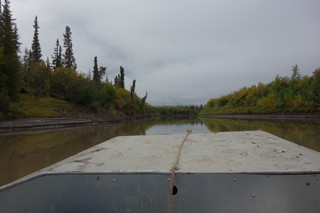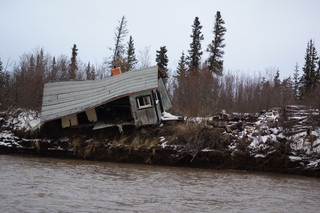There is a popular answer to this question among people who have had geography lessons and seen satellite images of deltas: usually, a delta is the area formed by the sediments of a river as it spills into another waterbody. It often features a fascinating network of meandering channels and distributaries, and its human land uses must adapt to the vagaries of a dynamic terrain characterized by land subsistence, flood risk, rampant erosion and high sediment loads.
Figure 1 is the view from the geography textbook. But what about the view from the delta itself, from the perspectives of the people whose home the delta is? Our recently published book “Delta Life” explores this perspective. Based on ethnographic research in eight river deltas around the world, and on critical readings of existing literature in anthropology, geography and beyond, this book treats river deltas as lifeworlds rather than as objects. The focus is squarely on “delta life”, by which we mean delta inhabitants’ everyday practices, worries, challenges and hopes. But why is this perspective useful, or even necessary?
First of all, we have learned that delta inhabitants quite often don’t live in “deltas”. How is this possible? Again, it is a question of perspectives, knowledges and experiences: from our geography-textbook point of view, we can identify particular people as delta inhabitants, but for them, their lives do not take place “in a delta”, but rather “on islands”, “on the coast”, “in a neglected neighbourhood” or “along the river” for example. Of course these lives are affected by the volatile waters and other dynamics that make river deltas into “hotspots” of global changes. But delta inhabitants neither experience nor accommodate these dynamics from the detached “delta” perspective, but as part of a range of other pressing issues that shape their lives: political marginalisation, economic dependency, cultural exclusion, etc.
Furthermore, we have found that delta inhabitants do not only accommodate these transformations and pressures, but they actively anticipate them and prepare accordingly. These are not the grand schemes of deltaic engineering that characterise many large-scale, capital-intensive plans for remaking deltas into fortresses against sea-level rise. But neither are these the dystopic visions of enduring or coping with unprecedented catastrophe, which some development agencies have established for deltas and their inhabitants. Instead, deltaic anticipations derive from experiences and observations and are always tentative, knowing that the tides can deceive people just like government workers and competing fishers can.
Another key advantage of paying attention to the lifeworlds of delta dwellers is that we can learn directly from their experiences and wisdom about what it means to live in dynamic river deltas in these uncertain times. This is a much better vantage point than having to rely on abstractions and projections gained from large data sets and GIS references. Of course, big data and GIS can be extremely useful, but they can also rather mislead us if they are used to second-guess what is actually happening on the ground, in the mud and throughout the waters. In fact, textbook-geography trained people direly need to learn how better to live in a volatile, uncertain world, as the recent IPCC Report has – again – made obvious. Delta inhabitants may be very apt teachers in this endeavour.
Finally, beginning with deltas as a life-world instead of an object can help in re-assessing taken-for-grated questions and formulations of the problem, which suggest their own answers and solutions. For instance, is the main question for delta inhabitants really how to best adapt to climate-change induced transformations? Indeed, thawing permafrost in arctic deltas, salinization in agricultural deltas or land subsidence in densely inhabited deltas are all deeply problematic. But one of the main lessons from ethnographic research with delta dwellers is that these problems never manifest on their own. Instead, for all practical purposes, they are always entwined with other significant structures and processes, including access to land and water, political representation and particular pursuits of a decent life.
For example, when we look at figure 3, the picture of an abandoned camp in the part of the Mackenzie Delta that belongs to the Gwich’in Settlement Area, we can see very different things, depending on our perspective. Taking a view informed by the delta gaze from above, we can understand this scene as an illustration of the global delta crisis: increasing erosion, accelerated by permafrost thaw and changing hydrological regimes, has undercut the cabin and will soon destroy the camp, jeopardizing the livelihoods of the family that used to occupy it. Conversely, by working with delta inhabitants, listening to their stories and accompanying their everyday tasks, we might see other things in the collapsing cabin: we might ask why the family that lived and produced furs and foods there no longer earns enough money to buy and maintain boats and snowmobiles, or inquire into other reasons for its owners abandoning their camp or their children moving to cities outside the delta.
In short, from a “delta life” perspective, collapsing homes are not just a matter of climate change, but have much wider, and equally fundamental, causes. In the Mackenzie Delta, these include a lifestyle that emerged in the context of colonial market structures like the fur trade and land grabbing, a region often dominated by short-term geopolitical entanglements with powerful centres elsewhere, including territorial claims in the High North, the Cold War or the oil crisis, which formed many dependencies of the Indigenous populations in the process, often as a result of explicit government policies like those forcing Indigenous children into residential schools in order to unlearn their languages and traditions.
The “Delta Life” book, available in print and – thanks to the publisher Berghahn’s collaboration with Knowledge Unlatched – as open-access e-book, explores these and many other delta issues in detail. At the same time, it makes clear that delta inhabitants around the world are not just victims of historical and ongoing inequalities and marginalisations, but that they forge their own lives and destinies, on their own terms, in an environment in which climate change is only one out of many challenges.
This blog post appears also on the blog of the publisher, Berghahn Books, with a direkt link to the OA version of the book.



